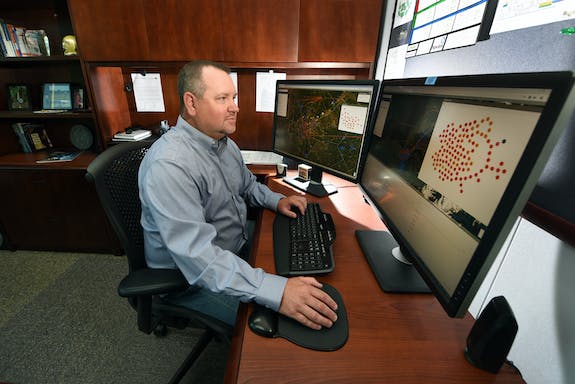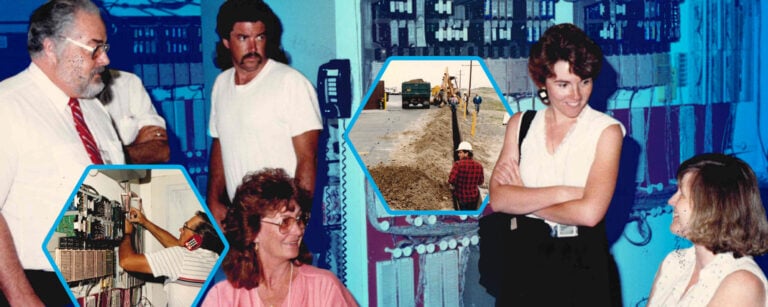In the weeks after Hurricane Maria hit Puerto Rico in September 2017, the world heard volumes about the storm’s impact in terms of lives lost, homes demolished and infrastructure destroyed.
But Maria had one lesser-known consequence that proved just as critical.
Maria damaged the manufacturing plants of a major IV bag maker, plunging hospitals into supply shortage that didn’t ripple across the mainland United States until six months after the hurricane made landfall.
Given the highly integrated nature of supply chains in the U.S., natural and man-made disasters can have unanticipated consequences that are every bit as serious as the immediate damage of the event itself.
Critical infrastructure is everywhere. As communities grow and evolve into complex networks of facilities, services and personnel, it’s increasingly challenging for emergency managers to know how a disruption to infrastructure or supply chains might affect the essential downstream services.
Now, INL researchers have developed a tool that will help emergency response managers anticipate the effects of these critical infrastructure dependencies and respond quickly after a disaster.
The All Hazards Analysis (AHA) software provides a framework and a methodology for mapping the relationships among vital and vulnerable assets.
Out of sight, out of mind
“In many cases, critical infrastructure is all around us, but it is out of sight, out of mind,” said Ryan Hruska, a Critical Infrastructure Research senior scientist at INL. “There are interesting feedback loops and issues that can be created, and we don’t understand the consequences unless we poke around a little bit.”

To develop a model for a town, county or region, emergency managers direct AHA to gather the information it needs about the essential infrastructure in the area of interest. Then, AHA uses machine-learning-enabled processes to integrate facility and systems information from various sources into the framework.
These sources can be structured, such as a database detailing all the substations operated by a given power plant, or unstructured, such as newspaper articles, technical references, design standards or incident reports from a website. For unstructured sources, AHA uses natural language processing, where algorithms are taught to recognize patterns in and extract information from human language texts.
Because AHA can collect data autonomously, it frees infrastructure emergency managers from the onerous task of providing and entering data themselves.
Managers can then simulate the loss of an infrastructure component within the framework to understand cascading effects that impact downstream services.
As more information is added, AHA’s models can evolve, becoming more accurate.
Just-in-time supply chains
Part of the challenge is that supply chains are evolving.
“All of those optimizations have potential far-reaching effects,” Hruska said. “You can disrupt a supply chain in one part of the U.S. that can affect people hundreds if not thousands of miles away. We’re trying to identify those critical supply chains: water, wastewater, electricity, fuels, telecommunications, even hospital supply chains, for blood products and medicines.”
For example, extreme cold weather in Texas might disrupt the delivery of natural gas, thereby cutting off gas supplies to electric generation plants in another state such as California. Or a tornado might cripple a plant that produces the chemicals necessary for a wastewater treatment facility to function.
AHA could help analyze not only public services, but also industrial supply chains, and the application is flexible enough to apply these scenarios to specific facilities.
For instance, a single natural gas refinery in the Mountain West has the capacity to produce nearly a quarter of the world’s helium supply in a given year. Aside from party balloons, helium is necessary for any number of industrial processes including everything from a coolant for MRI machines to arc welding. If that facility were damaged, it could hamper dozens of industries across the planet.
“Those are relationships where, unless you are at the facility or in that industry, the importance of a particular product or service goes unnoticed,” Hruska said.
Before disaster strikes
Emergency managers can use AHA to map and model the effects of natural and man-made incidents before a disaster strikes, enabling effective mitigation planning.
Or, in the wake of a disaster, managers can use these tools to respond more effectively. For example, AHA’s dependency model might help managers determine which essential services to recover first—say, restoring a power substation before a water treatment facility—because the treatment facility requires power to operate.
In short, AHA helps emergency crews respond to a loss of infrastructure faster and more efficiently. Power, water and other essential services are restored quickly so communities can return to normal.
AHA has been developed and tested on water, wastewater, communications and energy (electrical, oil and natural gas and petroleum), and critical manufacturing sectors. AHA was successfully used in a Department of Homeland Security (DHS) sponsored dependency pilot project and the AHA methodology was subsequently incorporated into a national-level DHS critical infrastructure portal.
“The ultimate goal is to use that information to help emergency managers across the emergency management framework prepare beforehand or respond quickly after a natural disaster,” Hruska said.






